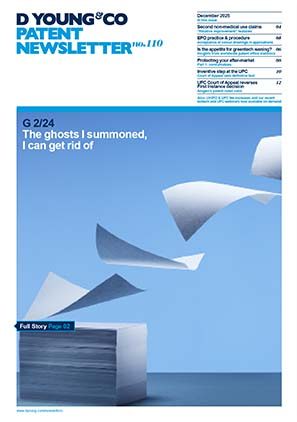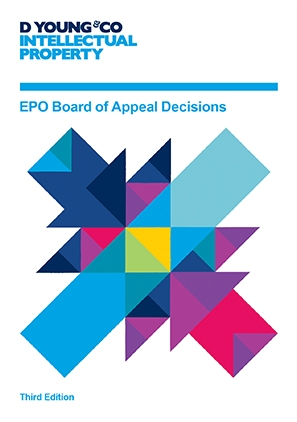Please specify me! CJEU tightens the net on SPC eligibility
The Court of Justice of the European Union (CJEU) has once again tightened the criteria on what types of patents for authorised pharmaceutical products can be extended by means of supplementary protection certificates (SPCs). This decision could have wide repercussions for many SPCs, both existing and in the future, and may cause innovator pharmaceutical companies to re-think their entire SPC strategy in Europe.
Background
It is common that a number of patents are filed and issued during the pharmaceutical research cycle. For example, early-stage research may identify a biological target which must be acted upon in order for a drug to treat the disease of interest. In addition to patenting the target itself, the innovator may look to claim compounds defined in a functional manner to act against this target, even before any such compounds have actually been made or tested.
Once the research cycle moves to the next step of making and testing the compounds, a patent application is typically filed claiming these compounds by means of a broad general formula (a so-called “genus” claim). However, it is sometimes the case that the specific compound which turns out to be the most suitable for development as a pharmaceutical only emerges from research carried out after the genus patent application is filed.
The combined effect of the above is that the same compound which is ultimately approved may fall under more than one patent. In addition to being disclosed and claimed specifically (a species claim) in a later-filed patent application, it may fall under the functional definition of the earlier target patent, as well as within the general formula of the genus patent, without being specifically disclosed in either. Sometimes, the species is never itself patented (as selection patents directed to the species are sometimes difficult to obtain) and the innovator is forced to rely purely on functional and/or genus claims to cover an approved product.
Article 3(c) of the EU medicinal products SPC Regulation (469/2009) permits only one SPC to be granted to each patent holder for a particular authorised product. Therefore, when the patent holder is faced with a choice of patents on which to base SPC protection (the basic patent), this can often be a tricky decision in which a number of competing factors must be balanced, including the strength and scope of the basic patent, the potential expiry date of the SPC, and the eligibility of the basic patent for SPC protection. It is the last of these issues which has been the subject of controversy in the EU for almost a decade.
Prior SPC case law – the specified test emerges
Article 3(a) of the SPC Regulation requires that, to be entitled to an SPC, the authorised product must be “protected” by a basic patent in force. There is general consensus among European SPC practitioners that this is not simply a matter of whether the product falls within the claims of the basic patent (the infringement test), but considerable uncertainty remains about what additional criteria must be satisfied.
The CJEU’s decision in Medeva (C-322/10) introduced into EU law the concept that the authorised product must be “specified” in the basic patent, in order for that patent to “protect” the product for the purposes of Article 3(a). However, despite many further referrals to the CJEU on this point, the court has repeatedly declined to give a clear answer on exactly what degree of “specificity” is required for the patent to be eligible for an SPC under Article 3(a).
In particular, to date the CJEU has provided no guidance as to whether the specified test of Article 3(a) allows a patent which covers an authorised product via a functional claim, or a genus claim, but does not specifically disclose the product, to “protect” the product for SPC purposes.
C-650/17 - the facts
The SPC which was the subject of the case is based on European patent no. EP1084705. This patent was based on early-stage research into inhibitors of the enzyme dipeptidyl peptidase IV (DPPIV), which were found to reduce blood sugar levels. The patent therefore claimed the use of DPPIV inhibitors, in a functional manner, to reduce blood glucose levels. However, it did not disclose or claim any specific DPPIV inhibitors. Following a number of assignments, the patent was granted to Royalty Pharma Collection Trust.
After this patent application was filed, a number of specific DPPIV inhibitors (gliptins) were developed and ultimately received marketing authorization (MA). Sitagliptin is one of these DPPIV inhibitors: it is sold as Januvia® by Merck. Sitagliptin specifically was also the subject of a later patent, which itself was extended by an SPC following issuance of the MA.
Royalty Pharma filed an SPC application for sitagliptin with the German Patent and Trade Mark Office (DPMA), on the basis of EP1084705 and Merck’s MA for Januvia®. They also filed a number of other similar SPC applications for other gliptins when these received MAs in the EU.
The DPMA refused the SPC application on the grounds that Article 3(a) was not met. Although acknowledging that sitagliptin met the functional definition of the DPPIV inhibitor in the patent, the DPMA held that, as the patent does not contain any specific disclosure of this product, the authorised product had not been provided to the skilled person. Based on this, the DPMA considered the grant of an SPC would be contrary to the objectives of the SPC Regulation.
Royalty Pharma appealed this decision to the German Federal Patent Court (Bundespatentgericht – BPatG), arguing the fact that the functional definition is met by sitagliptin should be sufficient for Article 3(a) to be met. It noted that other countries, including the UK, had granted corresponding SPCs. The BPatG referred the matter to the CJEU, asking the following three questions:
- Is a product “protected” by a basic patent in force pursuant to Article 3(a) [of the SPC Regulation] only if it forms part of the subject matter of protection defined by the claims and is thus provided to the expert as a specific embodiment?
- Is it not therefore sufficient for the requirements of Article 3(a) if the product in question satisfies the general functional definition of a class of active ingredients in the claims, but is not otherwise indicated in individualised form as a specific embodiment of the method protected by the basic patent?
- Is a product not protected by a basic patent in force under Article 3(a) if it is covered by the functional definition in the claims, but was developed only after the filing date of the basic patent as a result of an independent inventive step?
The CJEU’s decision
In reaching its decision, the CJEU referred to its earlier decision in Teva v Gilead (C-121/17). In that case, relating to a combination drug, the CJEU ruled that Article 3(a) was complied with if the following two tests were met:
(1) the combination of actives necessarily, in the light of the description and drawings of that patent, fall under the invention covered by the patent, and
(2) each of those active ingredients must be “specifically identifiable”, in the light of all the information disclosed by the patent, at the filing or priority date of the application.
The CJEU applied the same test to the present case, thereby confirming that it applies to mono-product SPCs as well as those for combination products.
In the present case the CJEU considered that test (1) was met: as sitagliptin met the functional definition of the patent, it fell under the invention covered by the patent. However, the CJEU was doubtful whether test (2) was met at the priority date of the patent given that sitagliptin was not individualized as a specific embodiment in the patent.
The CJEU reasoned that, even when the product which is the subject of the SPC application is not individualised as a specific embodiment within the teaching of the basic patent, the granting of an SPC based on this patent is, in principle, not excluded. However, in this particular case, the CJEU reasoned the skilled person must be able, at the filing or priority date, to infer directly and unambiguously from the specification of the patent as filed that the product for which SPC protection is sought falls within the scope of the protection of this patent.
Based on this, the CJEU answered questions 1 and 2 as meaning that a product is “protected” for the purpose of Article 3(a) if it meets a functional definition in the claims of the basic patent, without being individualised as a concrete embodiment to be learned from the teaching of said patent, provided that it is specifically identifiable, in the light of all the elements disclosed by the same patent, by the skilled person, on the basis of their general knowledge in the field as of the filing or priority date of the basic patent.
In answering question 3, the CJEU reasoned that if the results of research carried out after the filing or priority date of the patent could be taken into account for the purpose of SPC eligibility, such an SPC could allow its holder to unduly benefit from protection for these results, even though these were not known at the filing or priority date. The CJEU considered this would be contrary to the objective of the SPC Regulation, as such an SPC would not relate to the results of the research claimed under the patent.
Based on this, the CJEU ruled that, if the product was developed after the filing or priority date of the basic patent, following an independent inventive step, that product is not “protected” by the basic patent and Article 3(a) is not met.
Impact of the decision
It is regrettable that, yet again, the CJEU declined to give a clear answer on exactly what degree of “specificity” was required for the “specifically identifiable” test of Article 3(a) to be complied with, considering this was a matter for the referring court. It is notable, however, that the Court has now dispensed with the “core inventive advance” test developed in prior case law, considering it irrelevant as regards whether the basic patent “protects” the product under Article 3(a).
The CJEU’s answer on question 3 could have significant repercussions far beyond this particular case. Its ruling could call into question the validity of any SPC based on a patent having a functional claim or a genus claim, but where the product is only specifically disclosed in a later patent application which exhibits an inventive step over the earlier application. This could include many existing SPCs based on functional or genus patents, where a later species patent exists.
This decision may prompt the innovator pharmaceutical industry to re-think their SPC strategy in Europe and pivot towards filing SPCs based on patents which define the product more specifically, even if those patents are considered less robust than earlier-filed genus patents. Our firm’s SPC experts would be pleased to assist with development of this strategy.
Related webinar
Our January 2020 SPC webinar is now available on demand and covered key SPC case law including Teva v Gilead - C-121/17 and the UK court’s interpretation, C-650/17 and C-114/18 (how specific must you be?), C-239/19 (third party SPCs) and SPCs and Brexit.
Related event
Our European Biotech Patent Case Law webinar will run at 9am, noon and 5pm on Wednesday 08 July 2020, presented by European patent attorneys Catherine Keetch and Simon O’Brien from our biotechnology, chemistry & pharmaceuticals team.


